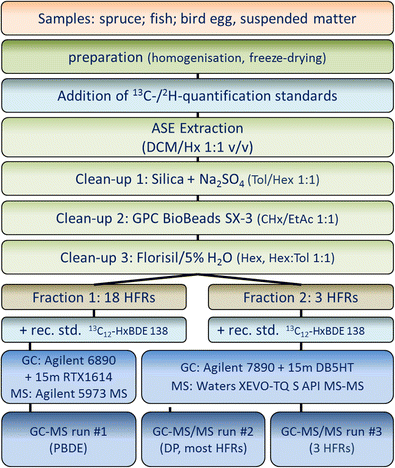Determination of halogenated flame retardants by GC-API-MS/MS and GC-EI-MS: a multi-compound multi-matrix method
Neugebauer, Frank; Dreyer, Annekatrin; Lohmann, Nina; Koschorreck, Jan
Analytical and Bioanalytical Chemistry (2017); online 13. Dezember 2017
Abstract
The extensive application of halogenated flame retardants has led to their widespread distribution in the environment. Recently, concerns emerged regarding their potential persistence, (bio)accumulation, and/or toxicity. Particularly halogenated flame retardants based on norbornene structures, like Dechlorane Plus as well as other brominated PBDE replacements, generically called emerging, novel, or alternative flame retardants, are in the focus of interest. A comprehensive analytical method for the determination of 21 halogenated flame retardants (HFRs) of different substance classes (dechloranes, brominated aromates, brominated ethers, cyclic BFR) in a broad variety of matrices (tree leaves, fish fillet, birds eggs, suspended particles) was developed in order to assess their environmental levels as well as temporal trends, especially for the use within environmental specimen banks (ESBs). In addition to the alternative HFRs, a set of 24 PBDEs were measured in the same samples, however using GC-EI-MS for detection. Samples were extracted using accelerated solvent extraction (ASE) with dichloromethane:hexane (exception: soxhlet extraction for suspended particles) followed by a multi column clean-up. Quantification was performed by API-GC-MS/MS as a modern, gentle, and sensitive technique for simultaneous detection of compounds throughout a wide range of masses and fragmentation characteristics (exception: PBDE detection using GC-EI-MS). With the exception of BDE 209, instrumental precisions of target compounds ranged from 1% to 16 % (at levels of 2 pg injection-1 for HFR, 20 pg injection-1 for DBDPE, 7-36 pg injection-1 for PBDEs). Interday precisions of the entire analytical method including extraction and clean-up were mostly below 25% for all validation matrices at spiked levels of 100 pg sample-1 for HFR (DBDPE: 1000 pg sample-1) and 1200–6000 pg sample-1 for PBDEs. The majority of analytes were investigated with expanded measurement uncertainties of less than 50%.
doi: 10.1007/s00216-017-0784-x
